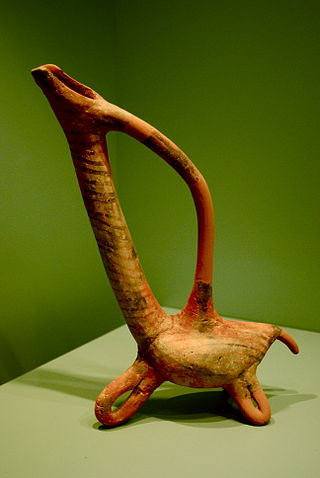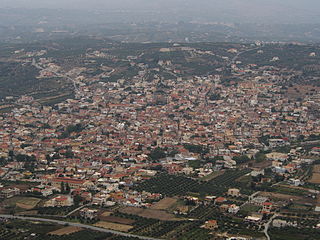
The Minoan civilization was a Bronze Age Aegean civilization on the island of Crete and other Aegean Islands, whose earliest beginnings date to c. 3500 BC, with the complex urban civilization beginning around 2000 BC, and then declining from c. 1450 BC until it ended around 1100 BC, during the early Greek Dark Ages, part of a wider bronze age collapse around the Mediterranean. It represents the first advanced civilization in Europe, leaving behind a number of massive building complexes, sophisticated art, and writing systems. Its economy benefited from a network of trade around much of the Mediterranean.

Gournia is the site of a Minoan palace complex on the island of Crete, Greece, excavated in the early 20th century by the American archaeologist, Harriet Boyd-Hawes. The original name for the site is unknown. The modern name comes from the abundant hollow vessels found all over the site. Gournia lies in the municipality of Ierapetra in the prefecture of Lasithi.

Zakros is a site on the eastern coast of the island of Crete, Greece, containing ruins from the Minoan civilization. The site is often known to archaeologists as Zakro or Kato Zakro. It is believed to have been one of the four main administrative centers of the Minoans, and its protected harbor and strategic location made it an important commercial hub for trade to the east. Flinders Petrie related Zakro with Tjeker of the Sea Peoples.
Spyridon Nikolaou Marinatos was a Greek archaeologist, best known for leading excavations at Akrotiri on Santorini (1967–74), where he died and is buried. He specialized in the Bronze Age Minoan and Mycenaean civilizations.

A mountain in north-central Crete, Mount Juktas, also spelled Iuktas, Iouktas, or Ioukhtas, was an important religious site for the Minoan civilization. Located a few kilometers from the palaces of Knossos and Fourni and the megaron at Vathypetro, Mount Juktas was the site of an important peak sanctuary in the Minoan world. At the base of Juktas, at Anemospilia, is a site that has suggested to some that the Minoans practiced human sacrifice, but the evidence is currently somewhat in question.

Karfi is an archaeological site high up in the Dikti Mountains in eastern Crete, Greece. The ancient name of the site is unknown; "Karfi" is a local toponym for the prominent knob of limestone that marks the peak of the site, especially when viewed from the north. Located approximately 1100 meters above sea level, and overlooking the northern entrance to the Lasithi Plateau, the dramatic situation of Karfi is somewhat akin to that of the famous Inca site of Machu Picchu in Peru. While there is some evidence that the site was used during the Middle Minoan period as a peak sanctuary, Karfi is best known as a large and extensively excavated town of the Late Minoan IIIC period at the beginning of the Greek "Dark Ages."

Koumasa is the site of a prepalatial cemetery on Crete. The cemetery is located between Loukia and Koumasa near the southern border of the Mesara plain, right at the foothills of the Asterousia-Mountains. This Minoan archaeological site was first excavated by Stephanos Xanthoudides from 1904 to 1906, which was published in The vaulted tombs of Mesara. After another campaign within the years 1991 and 1992 by Alexandra Karetsou and Athanasia Kanta, the site is investigated by the University of Heidelberg supervised by Prof. Dr. Diamantis Panagiotopoulos.

Tylisos is a town and a former municipality in the Heraklion regional unit, Crete, Greece. Since the 2011 local government reform it is part of the municipality Malevizi, of which it is a municipal unit. The municipal unit has an area of 131.064 km2 (50.604 sq mi). Population 2,867 in 2011. It is an ancient Minoan peak sanctuary and town. The Municipality of Tylisos was created in 1999 and includes 11 villages. The economy is based on agriculture, mainly grape cultivation and olive cultivation. At the same time stock farming of sheep, goats and chickens and beehive farms are abundant.
Apodoulou is the archaeological site of an ancient Minoan mansion or ceremonial building.

Sklavokampos is the archaeological site of an ancient Minoan settlement in Crete, used during the Late Minoan period.

Mochlos is a modern, populated, and inhabited island in the Gulf of Mirabello in eastern Crete, and the archaeological site of an ancient Minoan settlement. There is evidence that Mochlos was not an island in Minoan times, but was attached to the mainland and acted as an eastern harbor.

Phourni is the archaeological site of an ancient Minoan cemetery in Crete, established in 2400 BC and lasted until 1200 BC. Phourni is Greek for "furnace, oven" and the name of the hill on which the cemetery is located. Phourni is located at 70100 Epano Archanes, Heraklion, Greece—located on a hill in north-central Crete. Phourni can be seen from Mount Juktas. It is a small hill situated northwest of Archanes, between Archanes and Kato Archanes. Phourni is reachable from a signed scenic path that starts at Archanes. It was crucial for Minoan burials as many successful ones happened at this site. The burials consistently and proactively engaged the community of the Minoans. The largest cemetery in the Archanes area was discovered in 1957 and excavated for 25 years by Yiannis Sakellarakis, beginning in 1965. The 6600 sq m cemetery includes 26 funerary buildings of varying shapes and sizes. The necropolis of Phourni is of primary importance, both for the duration of its use and for the variety of its funerary monuments. All the pottery and much of the skeletal material was collected, unlike many other pre-palatial tombs. The cemetery was founded in the Ancient Minoan IIA, and continued to be used until the end of the Bronze Age. The occupation reached its peak during the Middle Minoan AI, just before the palaces of Knossos and Malia appeared. The proximity of Archanes to the important religious centres of Mount Iuktas probably contributed to the prominence of the site. The necropolis of Phourni is of primary importance, both for the duration of its use and for the variety of its funerary monuments. All the pottery and much of the skeletal material was collected, unlike many other pre-palatial tombs. The cemetery was founded in the Ancient Minoan IIA, and continued to be used until the end of the Bronze Age. The occupation reached its peak during the Middle Minoan AI, just before the palaces of Knossos and Malia appeared. The proximity of Archanes to the important religious centres of Mount Iuktas probably contributed to the prominence of the site.

Monastiraki is the archaeological site of an ancient Minoan town on the island of Crete. The site is on the plain of Amari, west of the Ida massif. Monastiraki is 38 kilometres from Rethymnon.
Nea Roumata is the archaeological site of an ancient Minoan tomb near the village of Nea Roumata in Chania regional unit, Crete, Greece.

Hagia Photia is an archaeological site of a fortified ancient Minoan building on eastern Crete. Sitia lies five kilometers to the west.

Archanes is a former municipality in the Heraklion regional unit, Crete, Greece. Since the 2011 local government reform it is part of the municipality Archanes-Asterousia, of which it is a municipal unit. The municipal unit has an area of 31.516 km2 (12.168 sq mi). Population 5,042 (2011). It is also the archaeological site of an ancient Minoan settlement in central Crete. The discovery of ancient roads leading from Archanes to Juktas, Anemospilia, Xeri Kara and Vathypetro indicate that Archanes was an important hub in the region during Minoan times. Archaeological evidence indicates that ancient Archanes spread out over the same area as the modern town of Archanes.

Dreros, also Driros, near Neapoli in the regional unit of Lasithi, Crete, is a post-Minoan archaeological site, 16 km northwest of Agios Nikolaos. Known only by a chance remark of the 9th-century Byzantine grammarian Theognostus, archaeology of the site shows Dreros to have been initially colonised by mainland Greeks in the early Archaic Period about the same time as Lato and Prinias.

Stylos or Stilos is a village and part of the Apokoronas municipal unit in the Chania regional unit of the Greek island of Crete. The Greek etymology of the name of the village is 'column' or 'pillar'. No existing topographical or surviving architectural feature could account for this naming.

Aptera or Apteron was an ancient city, now an archaeological site in western Crete, a kilometre inland from the southern shore of Souda Bay, about 13 km east of Chania in the municipality of Akrotiri.

Priniatikos Pyrgos is an archaeological site near Istron River, in the eastern Cretan regional unit of Lasithi, (Greece). The nearest big town is Agios Nikolaos, Crete. The site is on a coastal promontory. It appears to have been first settled in the Final Neolithic, circa 3000 BC. Nearby, there's a small resort town of Kalo Chorio, Lasithi. It is not to be confused with Myrtos Pyrgos on the south coast.

















